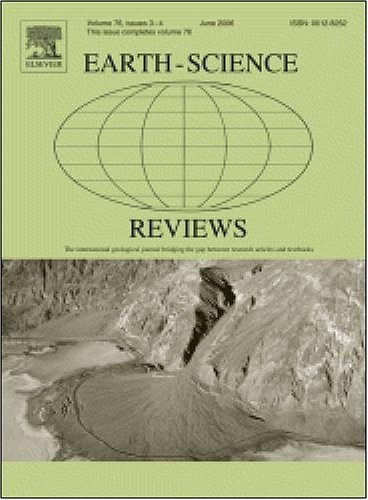Metamorphic evolution of Mesozoic microcontinent suture zones in the Tibet region
IF 10
1区 地球科学
Q1 GEOSCIENCES, MULTIDISCIPLINARY
引用次数: 0
Abstract
Microcontinent suture zones were generated by continental collision. However, collisional orogens often exhibit a series of metamorphic products with variable mineral assemblages. It is intriguing how crustal rocks at continental margins were metamorphosed at different geothermal gradients. In this study, we present a synthesis of metamorphic pressure (P), temperature (T) and time (t), as well as the P-T-t path, for Mesozoic medium- and high-grade metamorphic rocks in the Tibet region, focusing on fossil suture zones at Kangxiwa, Jinshajiang, Song Ma, Longmuco-Shuanghu, Changning-Menglian, Bangong-Nujiang, and Sumdo. The results show a series of common clockwise P-T-t paths, with metamorphic T/P ratios varying from 180 to 816 °C/GPa primarily in the Triassic and secondarily in the Permian and Jurassic. These thermobaric ratios allow for category of the target metamorphic rocks into low T/P Alpine type blueschist to eclogite facies series, moderate T/P Barrovian type amphibolite to granulite facies series, and high T/P Buchan type amphibolite to granulite facies series. These three types of metamorphic facies series were produced not only at variable geothermal gradients from 5.4 to 24.5 °C/km, but also at variable timescales from 25 to 60 Myr. The Alpine type metamorphism would mainly take place in the Triassic, indicating that the final closure of Paleo-Tethys Ocean is spatiotemporally associated with the opening of Neo-Tethys Ocean. The microcontinent assembly is predominated by the crustal cold subduction for the Alpine type metamorphism rather than the crustal warm collision for the prograde Barrovian type metamorphism. This difference indicates a relative lack of continental hard collision during the microcontinent assembly in the Triassic. Furthermore, the microcontinent suture zones were rarely remobilized in view of the rare Buchan type metamorphism in the Mesozoic. Nevertheless, the increase of metamorphic T/P ratios between these metamorphic rocks suggests the switch of dynamic regime from syn-collisional compression to post-collisional extension in these suture zones. In addition, time intervals for the dynamic switch vary from 25 to 60 Myr in the Mesozoic suture zones, suggesting differential periods of the tectonic transition from lithospheric thickening during the continental collision to lithosphere thinning. In either case, the Mesozoic Tibet region is considerably different in metamorphic evolution from either the Paleozoic ones in the northernmost margin or the Cenozoic one in the southernmost margin.
西藏地区中生代微大陆缝合带的变质演化
微大陆缝合带是由大陆碰撞形成的。然而,碰撞造山带往往表现出一系列具有可变矿物组合的变质产物。大陆边缘的地壳岩石是如何在不同的地热梯度下变质的,这很有趣。本文以康西洼、金沙江、松马、龙木-双湖、长宁-孟连、班公-怒江、松岛等地区为研究对象,对西藏地区中生代中、高档变质岩进行了变质压力(P)、温度(T)、时间(T)及P-T- T路径的综合研究。结果显示出一系列常见的顺时针P-T- T路径,变质T/P比值在180 ~ 816°C/GPa之间变化,主要发生在三叠纪,其次发生在二叠纪和侏罗纪。这些热压比可将目标变质岩划分为低温度/P阿尔卑斯型蓝片岩-榴辉岩相系列、中温度/P巴罗岩型角闪岩-麻粒岩相系列和高温度/P巴干型角闪岩-麻粒岩相系列。这三种变质相系列不仅产生于5.4 ~ 24.5°C/km的可变地热梯度,而且产生于25 ~ 60 Myr的可变时间尺度。阿尔卑斯型变质作用主要发生在三叠纪,表明古特提斯洋的最终闭合与新特提斯洋的打开在时空上存在关联。对于阿尔卑斯型变质作用,微大陆组合以地壳冷俯冲为主,而对于前进巴罗威型变质作用,微大陆组合以地壳暖碰撞为主。这一差异表明三叠纪微大陆组合时期相对缺乏大陆硬碰撞。此外,由于中生代少见的巴干型变质作用,微大陆缝合带很少被重新活化。然而,这些变质岩之间的变质T/P比值的增加表明,这些缝合带的动力机制从碰撞前压缩转向碰撞后伸展。此外,在中生代缝合带中,动态转换的时间间隔在25 ~ 60 Myr之间,表明大陆碰撞时岩石圈增厚到岩石圈减薄的构造过渡的不同时期。在这两种情况下,西藏中生代地区的变质演化与最北缘的古生代和最南缘的新生代都有很大的不同。
本文章由计算机程序翻译,如有差异,请以英文原文为准。
求助全文
约1分钟内获得全文
求助全文
来源期刊

Earth-Science Reviews
地学-地球科学综合
CiteScore
21.70
自引率
5.80%
发文量
294
审稿时长
15.1 weeks
期刊介绍:
Covering a much wider field than the usual specialist journals, Earth Science Reviews publishes review articles dealing with all aspects of Earth Sciences, and is an important vehicle for allowing readers to see their particular interest related to the Earth Sciences as a whole.
 求助内容:
求助内容: 应助结果提醒方式:
应助结果提醒方式:


